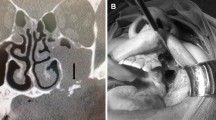Abstract
Until now, there is no optimal technique for repairing oronasal fistula in patients with prior head and neck radiotherapy and trismus. Use of the silicone button is a safe, office-based, and validated method in this situation. The indications of this procedure are also clarified in this study. This is a retrospective study of four patients who underwent a newly designed endoscopic repair of oronasal fistula with silicone button under local anesthesia from July 2012 to August 2012. Data on the size of the defect, length of operation, symptom relief, and post-operative complications were collected. Four patients underwent endoscopic repair of oronasal fistula with silicone button under local anesthesia. The diagnoses were benign palate lesion s/p operation, oral cancer s/p operation and radiotherapy. The defect diameter varied from 1 to 1.5 cm. The operation durations were between 20 and 30 min. In all cases, nasal regurgitation symptoms were relieved. The hypernasality of one case improved, while another had decreased nasal crusting and foul odors. No major complications were noted. There was a minor complication in one case, which exhibited frequent crusting around the silicone button. Silicon button can act as a temporary obturator to improve quality of life of patients. The indications for this procedure include patient undergone head and neck radiotherapy with (1) chronic fistula (>6 months); (2) small defect (1–2 cm); and (3) trismus.
Level of evidence: 4.



Similar content being viewed by others
References
Amaratunga NA (1986) Oro-antral fistulae. A study of clinical, radiological and treatment aspects. Br J Oral Maxillofac Surg 24:433–437
Killey HC, Kay LW (1972) Observations based on surgical closure of 362 oroantral fistulas. Int Surg 57:545–549
Lin PT, Bukachaevsky R, Blake M (1991) Management of odontogenic sinusitis with persistent oro-antral fistula. Ear Nose Throat J 70:488–490
Jeffery SL, Boorman JG, Dive DC (2000) Use of cartilage grafts for closure of cleft palate fistulae. Br J Plast Surg 53:551–554
Garner JM, Wein RO (2006) Use of the palatal flap for closure of an oronasal fistula. Am J Otolaryngol 27(4):268–270
Goiato MC, dos Santos DM, Miyahara GI et al (2011) Prosthetic treatments for patients with oronasal communication. J Craniofac Surg 22:1445–1447
Blind A, Hulterström A, Berggren D (2009) Treatment of nasal septal perforations with a custom-made prosthesis. Eur Arch Otorhinolaryngol 266(1):65–69
Price DL, Sherris DA, Kern EB (2003) Computed tomography for constructing custom nasal septal buttons. Arch Otolaryngol Head Neck Surg 129(11):1236–1239
Conflict of interest
The authors have no funding, financial relationships, or conflicts of interest to disclose
Author information
Authors and Affiliations
Corresponding author
Rights and permissions
About this article
Cite this article
Hsu, YT., Hao, SP. Repair of oronasal fistula with silicone button in patients with head and neck cancer. Eur Arch Otorhinolaryngol 272, 1477–1481 (2015). https://doi.org/10.1007/s00405-014-3069-4
Received:
Accepted:
Published:
Issue Date:
DOI: https://doi.org/10.1007/s00405-014-3069-4




